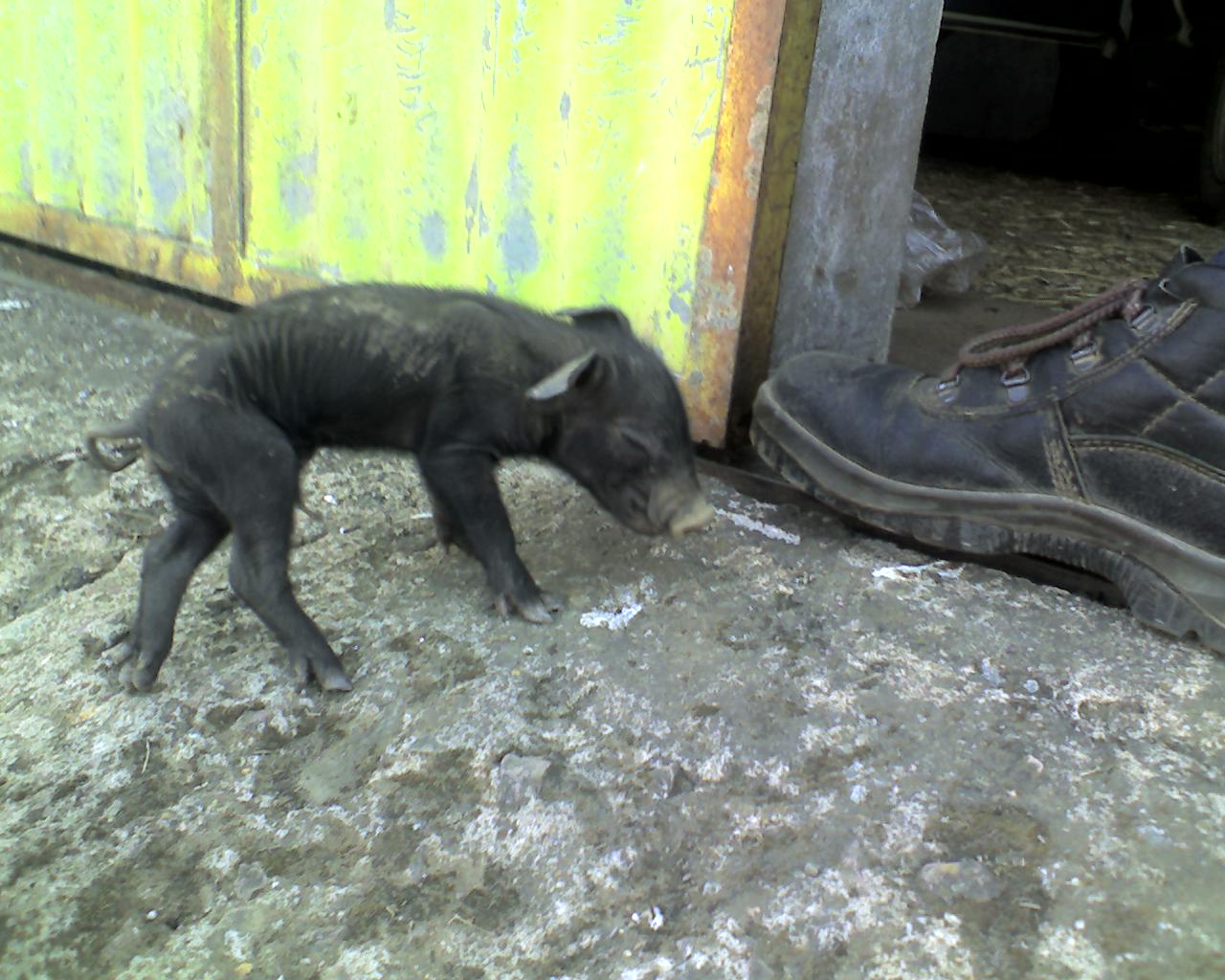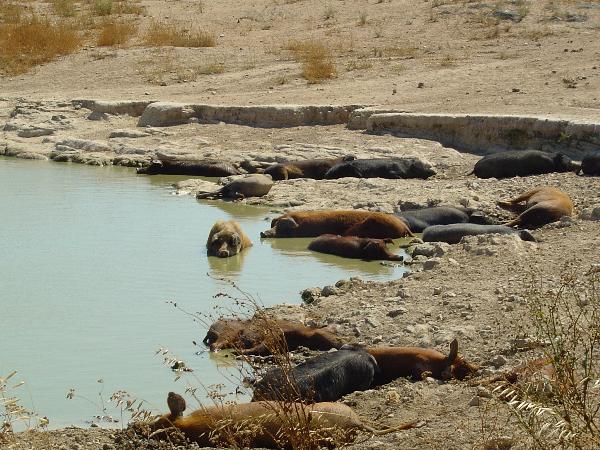|
O PORCO
Porco (Sus domesticus ou Sus scrofa domesticus) é um mamífero bunodonte não-ruminante, da família dos suidae. A espécie evoluiu a partir do javali selvagem, embora haja controvérsia quanto à subespécie exacta: há quem acredite que descendem do Sus scrofa scrofa, que habita grandes regiões da Eurásia, e também quem acredite que sua origem é o Sus scrofa vitatus, que vive na Ásia e na bacia do Mar Mediterrâneo.
É um animal maciço, de patas curtas terminadas por quatro dedos completos munidos de cascos. Sua cabeça tem perfil triangular e tem um focinho cartilaginoso. A dentadura, de tipo primitivo (44 dentes molares) apresenta caninos fussadores revirados e incisivos inferiores alongados (em forma de pá). Sua pele, de pelagem espaçada (e cor geralmente rosada) recobre uma espessa camada de toucinho.
Os porcos são animais omnívoros. Digerem bem todos os alimentos, excepto os celulósicos. Embora o consumo de sua carne seja proibido por algumas das principais religiões (como o Islamismo e o Judaísmo), a carne suína é a mais consumida no mundo (responde por 44% do mercado de carnes), sendo considerada saborosa por gastronómicos.
|
The Pig
Pigs, also called hogs or swine, are ungulates which have been domesticated as sources of food, leather, and similar products since ancient times. More recently, they have been involved in biomedical research and treatments, especially for their eyes and hearts, which closely resemble those of humans. Their long association with humans has led to their considerable representation in cultural milieux from paintings to proverbs.
Native to Eurasia, they are collectively grouped under the genus Sus within the Suidae family. Despite pigs' reputation for gluttony, and another reputation for dirtiness, a lesser known quality is their intelligence.
A pig has a snout for a nose, small eyes, and a small tail, which may be curly, kinked, or straight. It has a thick body, short legs, and coarse hair. There are four toes on each foot, with the two large middle toes used for walking.
Pigs are omnivores, which means that they consume both plants and animals. Pigs will scavenge and have been known to eat any kind of food, including dead insects, worms, tree bark, rotting carcasses, garbage, and even other pigs. In the wild, they are foraging animals, primarily eating leaves, grasses, roots, fruits and flowers.
|
|
O Porco Alentejano
O porco Alentejano é a ultima raça suína de pastoreio da Europa. Trata-se de uma raça diferente e única que hoje só se encontra no sudoeste da península ibérica, e que apresenta animais de corpulência média/pequena e pele preto-ardósia.
É o habitat de bosques de tipo mediterrânico, com grande abundância de azinheiras e sobreiros que lhes confere grande disponibilidade de bolotas e lande durante o Inverno, bem como ervas frescas e plantas aromáticas na primavera, importante complemento proteico.
Os únicos locais onde é permitida a transformação de carne de porco alentejano são os concelhos Barrancos e Ourique.

|
The Alentejo Hog
The alentejo pig is the last swine pasturing race in Europe. It's a different and unique breed that can only be found in the southwest of the Iberian peninsula and that presents individuals with medium/small bodies and dark-slate skin.
Their habitat is within the Mediterranean woods type, with great abundance of Holm and cork oaks, that provide plenty of acorn during winter, as well as fresh grass and aromatic Spring flower, protein important complement
The only places where is allowed the industry of the alentejo pig are the municipalities of Barrancos and Ourique.

|
|
A CACHE
Como toda a gente sabe, apesar do bicho porco ser um animal fascinante, é muitas vezes alvo de críticas injustas e exageradas relativamente à sua higiene. Por isso, resolvi que esta cache seria um tributo ao porco e não uma cache que obrigasse a conviver de muito perto com os animais.
Esta é uma multi-cache simples. No local inicial terão que contabilizar alguns dados e depois é só substituir de modo para obter as coordenadas finais:
N 37º 4A.BCA
W008º 0D.BE
A - O número de machos
B - O número de orelhas dos machos.
C - O número de machos + Número de orelhas das fêmeas.
D - O número de orelhas das fêmeas.
E - O número de patas das fêmeas + Número de orelhas das fêmeas
No local inicial devem tomar cuidado com o trânsito para não serem atropelados.
No local final basta ter alguma discrição durante a procura da cache e algum cuidado durante a noite pois este é procurado pelos namorados para as "suas actividades".
Se não conseguir fazer o Found, quer seja por não encontrar a cache quer seja por não a poder procurar, terá que cumprir estes requisitos para ser autorizado a fazer o log na cache final do Projecto Alentejo:
- terá que registar o Not Found, notes não valem.
-terá que provar que esteve mesmo lá. Uma fotografia sua abraçado a um dos animais no ponto inicial será essencial (uma ideia: porque não tirá-la logo, não vá fazer falta, e depois colocá-la com o log, independentemente do resultado da procura?).
|
THE CACHE
As everyone knows, besides the pig being a fascinating animal, is often target of exaggerated and unfair critics about its hygiene. Because of that I decided that this cache would be a tribute to the pig and not a cache that would make you to deal personally with the animals.
This is a simple multi-cache. At the initial point you'll have to make some counting and replace in way to get the final coordinates:
N 37º 4A.BCA
W008º 0D.BE
A - The number of males
B - The number of ears in the males
C - The number of males + number of ears in the females
D - The number of ears in the females
E - The number of legs in females + Number of ears in females
In the initial point take attention to the traffic in order not to be rammed by a car.
In the final location you only need to have some stealth and some attention at night because the place is searched by some couples to do "their things".
If you cannot make the Found, no matter it's because you can't find it or you cannot look for it, you'll have to fill this requirements to be authorized to log the found of the final Alentejo Project cache:
- You'll have to register your Not Found, notes aren't allowed.
-you'll have to prove that you've been there. A picture of you hugging one of the animals at the initial point will be essential (one thought: why not to take it at once, just in case, and then put it with the log?).
|